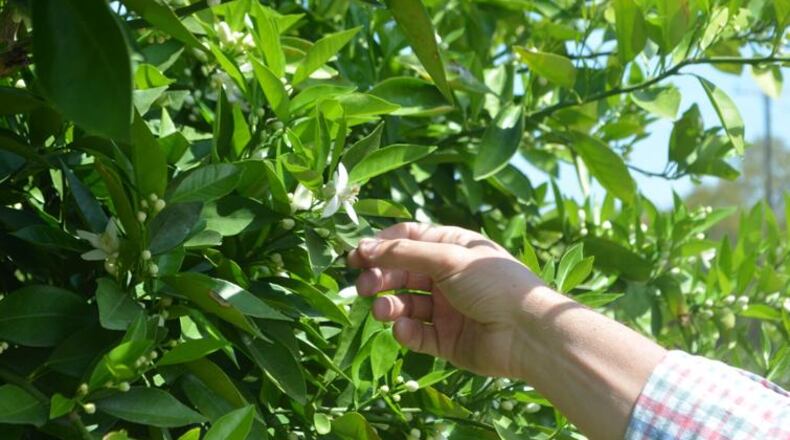SMITHVILLE – The first blossoms bloomed from the buds of Justin Jones’ navel orange trees on the first day of spring.
Jones, a Lee County farmer, has about 12,000 citrus trees across 70 acres of land in Smithville, Georgia. He grows primarily satsumas, along with the navel oranges. The latter were sprinkled with tiny white buds and flowers, and buzzing with honeybees. Jones said they’ll be in full bloom soon.
Earlier this month, temperatures reached the low-30s at night, but by mid-afternoon the sun had warmed the Earth. Sprinklers pumping 68-degree well water ran in defense of the cold morning temperatures. The water turns to steam when it hits the cold air, rising and creating a protective heat shield throughout the tree’s trunk and limbs.
“This October, if everything stays straight, we’ll have our first big year of production,” Jones said.
Credit: Lucille Lannigan
Credit: Lucille Lannigan
Jones pointed out some yellowing in leaves where frost had coated them, but it was no comparison to the previous winter’s cold temperatures. On Christmas Eve in 2022, temperatures reached 13 degrees and did not rise above freezing for two days.
The freezing temperatures damaged Jones’ trees – he fully lost a small percentage of navel trees. The satsuma trees were safe, as they are more resilient against cold temperatures.
Because of the damage, Jones and his team decided it would be best to remove the blooms to allow the trees to focus on recovery.
“We didn’t want to stress the tree, expecting it to grow back after the freeze and produce fruit,” he said.
Jones said another surprise freeze in mid-March 2023 took all of the blooms for them.
Because of the freeze, he said his citrus harvest last year was zero. Traces of the damage can be seen in brittle, leafless branches. He said his trees used to be twice their current size. Piles of dead sticks lie at the end of the orchard rows where he and his team had to cut back barren branches from the trees.
Jones said it was a learning experience and nothing he and other farmers did not expect as they entered the citrus industry, which is a relatively new industry in south Georgia.
Credit: Lucille Lannigan
Credit: Lucille Lannigan
Pam Knox, director of the UGA Weather Network and an Agricultural Climatologist, said across the state there’s been a rise in the average annual temperature by about 2.5 degrees from 1970 to present.
She said while year-to-year variability is more significant for farming habits, annual temperature averages shift the length of the growing season, which leaves room for experimenting with new crops.
Knox said citrus isn’t the only crop Georgia farmers are experimenting with. There’s also about 3,000 acres of olives across the state.
Jake Price, the UGA extension coordinator for Lowndes County, said he estimates about 4,000 acres of citrus is being grown across Georgia. He said the number grows each year.
Sixty-five percent of that acreage is satsuma oranges, a mandarin-like orange variety that is more cold hardy. However, other farmers have looked into different types of oranges as well as lemons, grapefruits and tangerines.
Jones began looking into citrus in 2016. He placed his first tree order within a nursery in 2017. By 2019, he had planted tiny trees, the size of a finger, on his farm.
He said the desire to diversify and lean into a more specialty crop pushed him in the citrus direction.
“Weather events seem to be more severe now than what they were in the past, so diversification is a huge factor in trying to ensure not to get totally wiped out,” Jones said.
Credit: Lucille Lannigan
Credit: Lucille Lannigan
He said he also was intrigued by the newness of the industry.
“The potential … and just really being able to get on the front end of it … interested me,” Jones said.
While citrus has a lot of potential in being a profitable crop, Jones said there’s risk in it as well.
Along with unexpected freezes, Georgia, he said, is not immune to citrus greening – a plant disease spread by an infected insect that has devastated millions of acres of citrus crops throughout the U.S. and internationally, according to the USDA.
While fruits impacted by citrus greening aren’t unsafe to eat, infected trees produce fruits that are green, bitter and unsuitable for sale. Infected trees also die within a few years.
The disease has crippled the citrus industry in Florida. The USDA’s Animal and Plant Health Inspection Service from 2022 estimated that citrus greening reduced Florida citrus production by 75% and more than doubled production costs.
“It’s a sad deal what it’s done to the industry in Florida,” Jones said. “A lot of good folks and farming families have lost a lot because of it.”
Price said there have been instances of citrus greening in Georgia, but it’s not prevalent. He urged people not to bring in trees from out of state, especially if they were grown outside.
“They could very well bring in diseases like citrus greening and canker,” he said. “You do not want to bring trees into Georgia unless they’re from a certified nursery ... grown inside.”
Canker is a similar disease that damages trees. He said he encourages people to remove trees that test positive for these diseases.
“There’s no enforcement mechanism to make people do that,” Price said. “We just hope that people will do it to try not to spread disease to this new industry, because if we get something like that it can be over with.”
Jones said Georgia does have some strengths in the face of citrus greening. The state’s temperatures are not conducive to the insect like they are in Florida, he said.
He also pointed out that, in Florida, there is citrus field after citrus field side by side, allowing the disease to move quickly. Jones’ citrus orchards are secluded. He said there is no one growing citrus within 20 miles of his farm.
Jones said Georgia and Florida are also on two different spectrums of the citrus industry. Most of Florida’s citrus goes toward producing fruit juice, while in Georgia they are selling the whole fresh fruit. This means the crop not only has to look good but taste good.
He said entering the citrus industry was a bit like entering the unknown.
“There was no handbook like we have in other crops,” Jones said. “We were relying on information from the University of Florida, which is great information, but at the same time, different weather, different soil, different growing seasons ... so we were trying to take that information and apply it to our area.”
He said each year brings a new lesson, especially with events like an unexpected freeze.
Jones’ trees are currently in their fifth growing or “leaf” season. He first harvested fruit from them in 2022. He’ll harvest this season in October and November.
“Trees will produce early in their life span, but getting them to produce a good quality piece of fruit will take about four years,” he said. “But you will get some fruit in year two, it just doesn’t taste good. It’s immature.”
He said to get to 2024 – the first real citrus harvest – was a labor of love.
“A tree will make you patient,” Jones said. “We’ve been waiting five years now. We’ll finally get to see the fruits of our labor.”
Credit: Albany Herald
Credit: Albany Herald
MEET OUR PARTNER
Today’s story comes from our partner the Albany Herald. The Albany Herald publishes daily in print and online at albanyherald.com, providing coverage of community news, events, and sports in Southwest Georgia.
If you have any feedback or questions about our partnerships, you can contact Senior Manager of Partnerships Nicole Williams via email at nicole.williams@ajc.com.
About the Author
The Latest
Featured







